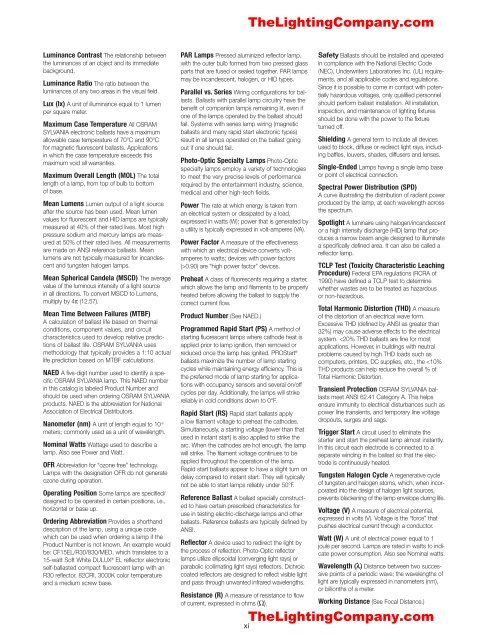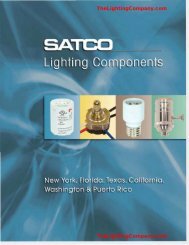Lamp and Ballast Catalog - The Lighting Company
Lamp and Ballast Catalog - The Lighting Company
Lamp and Ballast Catalog - The Lighting Company
- No tags were found...
You also want an ePaper? Increase the reach of your titles
YUMPU automatically turns print PDFs into web optimized ePapers that Google loves.
<strong>The</strong><strong>Lighting</strong><strong>Company</strong>.com<br />
Luminance Contrast <strong>The</strong> relationship between<br />
the luminances of an object <strong>and</strong> its immediate<br />
background.<br />
Luminance Ratio <strong>The</strong> ratio between the<br />
luminances of any two areas in the visual field.<br />
Lux (lx) A unit of illuminance equal to 1 lumen<br />
per square meter.<br />
Maximum Case Temperature All OSRAM<br />
SYLVANIA electronic ballasts have a maximum<br />
allowable case temperature of 70°C <strong>and</strong> 90°C<br />
for magnetic fluorescent ballasts. Applications<br />
in which the case temperature exceeds this<br />
maximum void all warranties.<br />
Maximum Overall Length (MOL) <strong>The</strong> total<br />
length of a lamp, from top of bulb to bottom<br />
of base.<br />
Mean Lumens Lumen output of a light source<br />
after the source has been used. Mean lumen<br />
values for fluorescent <strong>and</strong> HID lamps are typically<br />
measured at 40% of their rated lives. Most high<br />
pressure sodium <strong>and</strong> mercury lamps are measured<br />
at 50% of their rated lives. All measurements<br />
are made on ANSI reference ballasts. Mean<br />
lumens are not typically measured for inc<strong>and</strong>escent<br />
<strong>and</strong> tungsten halogen lamps.<br />
Mean Spherical C<strong>and</strong>ela (MSCD) <strong>The</strong> average<br />
value of the luminous intensity of a light source<br />
in all directions. To convert MSCD to Lumens,<br />
multiply by 4π (12.57).<br />
Mean Time Between Failures (MTBF)<br />
A calculation of ballast life based on thermal<br />
conditions, component values, <strong>and</strong> circuit<br />
characteristics used to develop relative predictions<br />
of ballast life. OSRAM SYLVANIA uses<br />
methodology that typically provides a 1:10 actual<br />
life prediction based on MTBF calculations.<br />
NAED A five-digit number used to identify a specific<br />
OSRAM SYLVANIA lamp. This NAED number<br />
in this catalog is labeled Product Number <strong>and</strong><br />
should be used when ordering OSRAM SYLVANIA<br />
products. NAED is the abbreviation for National<br />
Association of Electrical Distributors.<br />
Nanometer (nm) A unit of length equal to 10 -9<br />
meters; commonly used as a unit of wavelength.<br />
Nominal Watts Wattage used to describe a<br />
lamp. Also see Power <strong>and</strong> Watt.<br />
OFR Abbreviation for “ozone free” technology.<br />
<strong>Lamp</strong>s with the designation OFR do not generate<br />
ozone during operation.<br />
Operating Position Some lamps are specified/<br />
designed to be operated in certain positions, i.e.,<br />
horizontal or base up.<br />
Ordering Abbreviation Provides a shorth<strong>and</strong><br />
description of the lamp, using a unique code<br />
which can be used when ordering a lamp if the<br />
Product Number is not known. An example would<br />
be: CF15EL/R30/830/MED, which translates to a<br />
15-watt Soft White DULUX ® EL reflector electronic<br />
self-ballasted compact fluorescent lamp with an<br />
R30 reflector, 82CRI, 3000K color temperature<br />
<strong>and</strong> a medium screw base.<br />
PAR <strong>Lamp</strong>s Pressed aluminized reflector lamp,<br />
with the outer bulb formed from two pressed glass<br />
parts that are fused or sealed together. PAR lamps<br />
may be inc<strong>and</strong>escent, halogen, or HID types.<br />
Parallel vs. Series Wiring configurations for ballasts.<br />
<strong>Ballast</strong>s with parallel lamp circuitry have the<br />
benefit of companion lamps remaining lit, even if<br />
one of the lamps operated by the ballast should<br />
fail. Systems with series lamp wiring (magnetic<br />
ballasts <strong>and</strong> many rapid start electronic types)<br />
result in all lamps operated on the ballast going<br />
out if one should fail.<br />
Photo-Optic Specialty <strong>Lamp</strong>s Photo-Optic<br />
specialty lamps employ a variety of technologies<br />
to meet the very precise levels of performance<br />
required by the entertainment industry, science,<br />
medical <strong>and</strong> other high-tech fields.<br />
Power <strong>The</strong> rate at which energy is taken from<br />
an electrical system or dissipated by a load,<br />
expressed in watts (W); power that is generated by<br />
a utility is typically expressed in volt-amperes (VA).<br />
Power Factor A measure of the effectiveness<br />
with which an electrical device converts voltamperes<br />
to watts; devices with power factors<br />
(>0.90) are “high power factor” devices.<br />
Preheat A class of fluorescents requiring a starter,<br />
which allows the lamp <strong>and</strong> filaments to be properly<br />
heated before allowing the ballast to supply the<br />
correct current flow.<br />
Product Number (See NAED.)<br />
Programmed Rapid Start (PS) A method of<br />
starting fluorescent lamps where cathode heat is<br />
applied prior to lamp ignition, then removed or<br />
reduced once the lamp has ignited. PROStart ®<br />
ballasts maximize the number of lamp starting<br />
cycles while maintaining energy efficiency. This is<br />
the preferred mode of lamp starting for applications<br />
with occupancy sensors <strong>and</strong> several on/off<br />
cycles per day. Additionally, the lamps will strike<br />
reliably in cold conditions down to 0°F.<br />
Rapid Start (RS) Rapid start ballasts apply<br />
a low filament voltage to preheat the cathodes.<br />
Simultaneously, a starting voltage (lower than that<br />
used in instant start) is also applied to strike the<br />
arc. When the cathodes are hot enough, the lamp<br />
will strike. <strong>The</strong> filament voltage continues to be<br />
applied throughout the operation of the lamp.<br />
Rapid start ballasts appear to have a slight turn on<br />
delay compared to instant start. <strong>The</strong>y will typically<br />
not be able to start lamps reliably under 50°F.<br />
Reference <strong>Ballast</strong> A ballast specially constructed<br />
to have certain prescribed characteristics for<br />
use in testing electric-discharge lamps <strong>and</strong> other<br />
ballasts. Reference ballasts are typically defined by<br />
ANSI.<br />
Reflector A device used to redirect the light by<br />
the process of reflection. Photo-Optic reflector<br />
lamps utilize ellipsoidal (converging light rays) or<br />
parabolic (collimating light rays) reflectors. Dichroic<br />
coated reflectors are designed to reflect visible light<br />
<strong>and</strong> pass through unwanted infrared wavelengths.<br />
Resistance (R) A measure of resistance to flow<br />
of current, expressed in ohms (Ω).<br />
xi<br />
Safety <strong>Ballast</strong>s should be installed <strong>and</strong> operated<br />
in compliance with the National Electric Code<br />
(NEC), Underwriters Laboratories Inc. (UL) requirements,<br />
<strong>and</strong> all applicable codes <strong>and</strong> regulations.<br />
Since it is possible to come in contact with potentially<br />
hazardous voltages, only qualified personnel<br />
should perform ballast installation. All installation,<br />
inspection, <strong>and</strong> maintenance of lighting fixtures<br />
should be done with the power to the fixture<br />
turned off.<br />
Shielding A general term to include all devices<br />
used to block, diffuse or redirect light rays, including<br />
baffles, louvers, shades, diffusers <strong>and</strong> lenses.<br />
Single-Ended <strong>Lamp</strong>s having a single lamp base<br />
or point of electrical connection.<br />
Spectral Power Distribution (SPD)<br />
A curve illustrating the distribution of radiant power<br />
produced by the lamp, at each wavelength across<br />
the spectrum.<br />
Spotlight A luminaire using halogen/inc<strong>and</strong>escent<br />
or a high intensity discharge (HID) lamp that produces<br />
a narrow beam angle designed to illuminate<br />
a specifically defined area. It can also be called a<br />
reflector lamp.<br />
TCLP Test (Toxicity Characteristic Leaching<br />
Procedure) Federal EPA regulations (RCRA of<br />
1990) have defined a TCLP test to determine<br />
whether wastes are to be treated as hazardous<br />
or non-hazardous.<br />
Total Harmonic Distortion (THD) A measure<br />
of the distortion of an electrical wave form.<br />
Excessive THD (defined by ANSI as greater than<br />
32%) may cause adverse effects to the electrical<br />
system.




